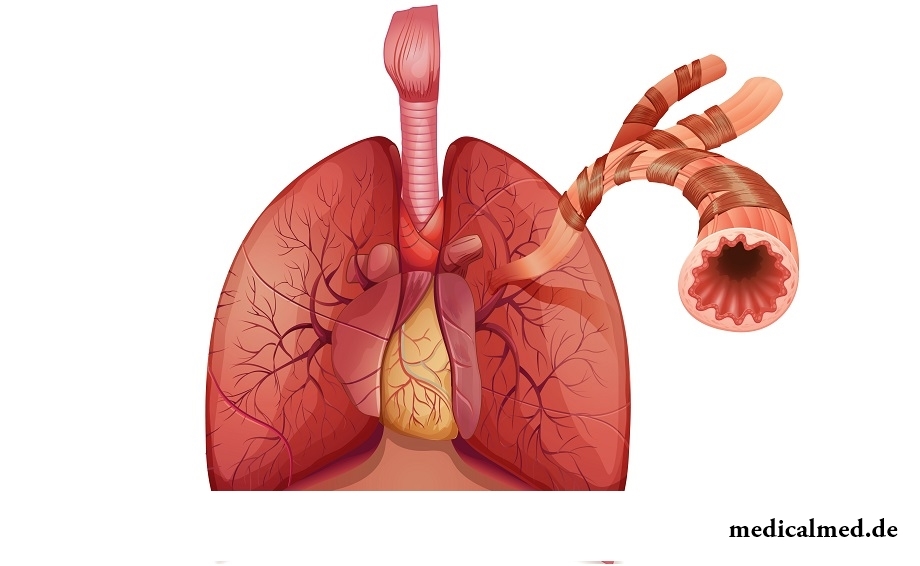





Bronchial tubes
Bronchial tubes. General characteristic
Bronchial tubes carry to a part of the ways which are carrying out air. Representing tubular branches of a trachea, they connect it to respiratory tissue of a lung (parenchyma).

At the level of 5-6 of a chest vertebra the trachea is divided into two primary bronchi: right and left, each of which enters the lung corresponding to it. In lungs bronchial tubes branch, forming a bronchial tree with enormous cross-sectional area: about 11800 cm2.
The sizes of bronchial tubes differ among themselves. So, right its length – from 2 to 3 cm, length of the left bronchial tube – 4-6 cm is shorter and wider left. Also the sizes of bronchial tubes differ by gender: at women they are shorter, than at men.
The upper surface of the right bronchial tube adjoins to tracheobronchial lymph nodes and an unpaired vein, a back surface – with a vagus nerve, its branches, and also to a gullet, a chest channel and a back right bronchial artery. The lower and front surfaces – with a lymph node and a pulmonary artery respectively.
The upper surface of the left bronchial tube adjoins to an aortic arch, back – to the descending aorta and branches of a vagus nerve, a lobby – to a bronchial artery, lower – to lymph nodes.
Structure of bronchial tubes
The structure of bronchial tubes differs depending on their order. In process of reduction of diameter of a bronchial tube their cover becomes softer, losing a hryashchevatost. However there are also common features. Allocate three covers forming bronchial walls:
- Mucous. It is covered with a ciliate epithelium, located in several rows. Besides, in its structure several kinds of cells are found, each of which performs the functions. Scyphoid form a mucous secret, neuroendocrinal cosecrete serotonin, intermediate and basal take part in recovery of a mucous membrane;
- Fibromuscular cartilaginous. At the heart of its structure – not closed hyaline cartilaginous rings fastened among themselves with a layer of fibrous fabric;
- Adventitious. The cover formed by the connecting fabric having a friable and not properly executed structure.
Functions of bronchial tubes
The main function of bronchial tubes consists in oxygen transport from a trachea to alveoluses of lungs. Other function of bronchial tubes, due to existence at them of cilia and ability to form slime, is protective. Besides, they are responsible for formation of a tussive reflex which helps to eliminate particles of dust and other foreign bodys.
At last, air, passing on long network of bronchial tubes, it is humidified and warmed up to the necessary temperature.
From here it is clear that treatment of bronchial tubes at diseases – one of the main objectives.
Diseases of bronchial tubes
One of the most often found diseases of bronchial tubes are described below:
- Chronic bronchitis represents a disease at which the inflammation of bronchial tubes and emergence of sclerous changes in them is observed. Cough (constant or periodic) with expectoration is characteristic of it. Its duration makes not less than 3 months within one year, extent – not less than 2 years. The probability of emergence of aggravations and remissions is high. Auscultation of lungs allows to define the rigid vesicular breath which is followed by rattles in bronchial tubes;
- Bronchiectasias represent expansions which cause an inflammation of bronchial tubes, dystrophy or a sclerosis of their walls. Quite often on the basis of this phenomenon there is a bronchoectatic disease which is characterized by an inflammation of bronchial tubes and emergence of purulent process in their lower part. One of the main symptoms of a bronchoectatic disease is the cough which is followed by allocation of plentiful quantity of a phlegm with the content of pus. The pneumorrhagia and pulmonary bleedings is in certain cases observed. Auscultation allows to define the weakened vesicular breath which is followed by dry and wet rattles in bronchial tubes. Most often the disease arises at children's or youthful age;
- at bronchial asthma the pant which is followed by suffocation, hypersecretion and a bronchospasm is observed. The disease belongs to chronic, is caused or heredity, or – the postponed infectious diseases of a respiratory organs (including bronchitis). The suffocation attacks which are the main manifestations by diseases most often disturb the patient during the night periods. Constraint in a breast, sharp pains in the field of the right hypochondrium are also quite often observed. Adequately picked up treatment of bronchial tubes at this disease allows to reduce the frequency of attacks;
- The Bronkhospastichesky syndrome (also known as a bronchospasm) is characterized by a spasm of unstriated muscles of bronchial tubes at which an asthma is observed. Most often it has sudden character and quite often passes into a condition of suffocation. The situation is aggravated due to allocation with bronchial tubes of a secret which worsens their passability, complicating a breath even more. As a rule, the bronchospasm is the state accompanying some diseases: bronchial asthma, chronic bronchitis, emphysema of lungs.
Methods of a research of bronchial tubes
Existence of the whole complex of the procedures helping to estimate correctness of a structure of bronchial tubes and their state at diseases allows to pick up the most adequate treatment of bronchial tubes otherwise.
One of the main and checked ways is poll at which complaints to cough, its features, existence of an asthma, pneumorrhagia and other symptoms are noted. It is also necessary to note existence of those factors that negatively influence a condition of bronchial tubes: smoking, work in the conditions of the increased air pollution, etc. Special attention should be paid on outward of the patient: skin color, shape of a thorax and other, specific symptoms.
Auscultation – a method which allows to define existence of changes in breath, including rattles in bronchial tubes (dry, wet, srednepuzyrchaty, etc.), rigidity of breath and others.
By means of X-ray inspection it is possible to reveal existence of expansions of roots of lungs, and also disturbances in the pulmonary drawing that is characteristic of chronic bronchitis. A characteristic sign of a bronchiectasia is expansion of a gleam of bronchial tubes and consolidation of their walls. For tumors of bronchial tubes local blackout of a lung is peculiar.
The spirography – the functional method of a research of a condition of bronchial tubes allowing to estimate type of disturbance of their ventilation. It is effective at bronchitis and bronchial asthma. In its basis – the principle of measurement of vital capacity of lungs, volume of the forced exhalation and other indicators.
Scientists from the Oxford university conducted a number of researches during which they came to a conclusion that vegetarianism can be harmful to a human brain as leads to decrease in its weight. Therefore scientists recommend not to exclude completely from the diet fish and meat.

It seems, quite recently you brought the baby from maternity hospital, but time flew by, and here it is already going to join the first...
Section: Articles about health
Proofs of efficiency of Mildronate at treatment of coronary heart disease with stenocardia can be found in many publications of the end of the twentieth century. Researches were conducted since 1984, including placebo - controlled effects. In total клиничес...
Section: Articles about health
History of mankind contains several tens of epidemics whose emergence was compared by eyewitnesses and historians to doomsday. The most terrible of them claimed the lives of millions of people, having made even the whole people to the person of the earth. What they − the diseases striking terror? Whether it managed to the person to find treatment, or he is still powerless before forces of nature?...
Section: Articles about health
Women quite often suffer from complexes concerning the sizes of the bust. Strangely enough, reason душевног...
Section: Articles about health
All know that self-treatment is dangerous. However absolutely it is almost impossible to do without it. Rate of modern life does not allow to handle each small trouble to the doctor and information on ways of independent rendering medical the help...
Section: Articles about health
It is difficult to revaluate importance of kidneys for an organism. These bodies not only perform work on purification of blood of decomposition products and removal of excess liquid. They are responsible also for production of some hormones necessary for maintenance of a normality of a bone tissue, and also for a producing red blood cells – erythrocytes....
Section: Articles about health
The body of the person almost for 60% consists of water. It is so important for normal functioning of an organism that loss of all is ponut...
Section: Articles about health
At this plant there are a lot of names: tuberiferous sunflower, Jerusalem artichoke, solar root, earth pear. Contrary to popular belief, it is not an exotic plant at all. The wild girasol grows in a midland of Russia practically everywhere: at the edges of roads...
Section: Articles about health
Cystitis, or inflammation of a mucous membrane of a bladder, this very widespread disease which, owing to some features of a structure of bodies of urinogenital system, women have approximately four times more often than men. Women aged from 20 up to 45 years enter into the main risk group. Cystitis is an illness of a bacterial origin. It can have an acute or chronic current. The second option is dangerous not only a frequent recurrence, серьезн...
Section: Articles about health
Scientists have no unambiguous opinion on a proximate cause of emergence of a carcinoma cutaneum today. Are precisely established only фа...
Section: Articles about health
The sudden heat on all body which is followed by perspiration and a cardiopalmus – the phenomenon familiar to many people. Most often such states called by "inflows" result from nervous or physical overworks and disappear right after rest. Odn...
Section: Articles about health
Long time antibiotics were considered as a panacea from all diseases and were appointed even at insignificant symptoms of an infection. Even now not everyone knows in what force of antibiotics how and when they should be accepted. Let's discredit 7 popular myths about such drugs....
Section: Articles about health
Tea is loved and use almost everything. This drink has tonic properties, contains the tannins capable podavlit...
Section: Articles about health
Transfusion of donor blood has almost century history. In spite of the fact that this procedure is quite usual for many people, process of blood donation is still surrounded with numerous myths. Today we aimed to discredit the most widespread of them....
Section: Articles about health
Cold – a state known to everyone which is followed by cold, cough, high temperature, a pharyngalgia. Often the first that we begin to do in hope again to become healthy – to accept medicines which are not always harmless whereas it is easy to facilitate displays of a disease by means of natural means. They not only softly eliminate disease symptoms, but also enrich the weakened organism with useful substances. We present you 8 drinks which are successfully used for...
Section: Articles about health
Smack in a mouth can arise in the natural way – as a result of lack of morning hygiene or reception of the corresponding food. Odn...
Section: Articles about health
Good appetite was always considered as a sign of good health. The correct operation of the mechanism which is responsible for the need for nutrients and receiving pleasure from process of its satisfaction demonstrates that the organism functions without special from...
Section: Articles about health
Musicotherapy – a treatment method which caused and causes a set of a controversy concerning its efficiency. However the facts are relentless: during the numerous researches curative impact of music on an organism was scientifically confirmed. Since then in a number of the countries the technique is included complex therapy of diseases of cardiovascular and respiratory system, dorsodynias and a backbone, psychosomatic disturbances and many other illnesses. The musicotherapy in a pedi is especially widely applied...
Section: Articles about health
About influence of fasting days on an organism it is told much – both about advantages, and about shortcomings. It is considered that fasting day...
Section: Articles about health
Any of us is not insured from a heavy illness of the loved one. Happens and so that someone from family members becomes the bed patient, and remains in such state for a long time. It extremely suppresses both the most injured, and all it to...
Section: Articles about health
There comes the season of issues. Many Russians already dream of outdoor recreation, trips, beautiful seaside beaches. At this time there is no wish to think of problems with health and other unpleasant things, however there are subjects which require attention. In the summer repeatedly the risk increases to ache with some very dangerous illnesses, we also will talk about them today....
Section: Articles about health
The state of health of the person in many respects depends on food. The organism will well function if during food it are...
Section: Articles about health
For many spouses the question of planning of a family is one of the main. The problem of the choice of effective and safe contraceptives at the same time comes out on top. Russians still not often resort to operation of a vasectomy extremely popular in the USA...
Section: Articles about health
New year, wedding, birthday, office party – an occasion to drink at the Russian person will always be. How to reduce a negative impact of alcohol by an organism and to avoid a condition of strong intoxication? The most correct council – to refuse the use of alcoholic drinks. Council is true, but not always feasible. We offer several advice which will help you in cases when it is impossible to avoid alcohol intake....
Section: Articles about health
Cold, puffiness of a nose, itch, the watering eyes - characteristic symptoms of the allergic rhinitis resulting from hit and...
Section: Articles about health
Ayurveda - the most ancient tselitelsky practice which came to us from India. It represents the doctrine about maintenance of physical, psychological and moral health of the person by means of the complex of procedures including a diet, cleaning of an organism, respiratory упр...
Section: Articles about health
Such trouble as the milkwoman's attack, at least once in life happened almost to each woman. Prevalence of a disease is explained by the fact that the causative agent of an illness belongs to the so-called opportunistic microflora living on mucous membranes of any human body and which is becoming more active only under favorable conditions. If you had curdled allocations from a vagina, the itch and burning in external genitals, or painful feelings disturb at sex...
Section: Articles about health
